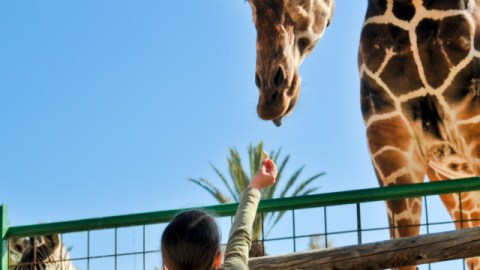Is animal captivity wrong?

Animals behind cages, starving and dying, is an awful sight. It’s an image that underlines the callousness with which humans treat other creatures and indeed themselves. The philosopher, Immanuel Kant, said in his Lectures on Ethics: “he who is cruel to animals becomes hard also in his dealings with men”. However true this is, it does highlight that causing suffering in general should be viewed as a bad thing – irrespective of whether we’re causing the suffering of a human or non-human.
The inability to sympathise with suffering, regardless of where that suffering is located, is a trait no moral individual should yearn for. We should be hesitant about what the effects are from (over)exposure to suffering many of us experience.
But too often, the causes of suffering tend to smudge our ethical vision of what truly is wrong. Animals in cages might automatically lead to us responding with disdain, but captivity might not be as awful as we think.
This doesn’t mean all or even most captivity is a good thing – only that we shouldn’t say “all captivity is bad” or, the corollary, “all animals free ‘in the wild’ is good”. Also note, I will view “being in zoos” and “being in captivity” as synonymous, as a shorthand approach.
Managing needs
Consider how we manage our needs.
In most cases, we assess our available resources against current requirements. Can we afford to buy this food? Should we sell this or get a better version of that? Do we donate a lot to charity this month or in small portions every month? Etc. Non-human animals, too, manage themselves in similar fashion, though they naturally do not have as advanced calculating abilities, deduction and communication skills, and environmental awareness as the best of humans.
Everything being equal, who we want to manage resources so that all can benefit should be the most capable humans – not (the most capable) non-human animals.
As research shows, animals in captivity tend to live longer than those in the wild. Things aren’t equal for animals in the wild: most are prey to another, more vicious animal. Every day is a struggle to survive, there is no guarantee of shelter, of food, of nourishment and of protection. But when animals are at, say, good zoos, vets can manage the animals’ lives better by providing them with the necessary care, as The Smithsonian recently highlighted. Food, shelter, health care are aspects that can be provided.
Living longer isn’t necessarily a better thing – for humans or non-human animals; however, a “reduced” lifespan is usually indicative of being killed, rather than a so-called “natural” death. And predation causes great amounts of suffering, since predators are not known for making death painless.
Thus, in captivity, predation – causing great suffering – is prevented, while animals are still provided the necessary substances (this assumes we have ethically and humanely killed a predator’s prey to feed the predator).
The natural world and the wild aren’t magical places
Indeed, left by themselves, animals could hurt themselves and each other (and vegetation) in other ways, if there is no human involvement.
For example, as The Humane Society of the United States highlights, animal populations sometimes need to be controlled, since too many could populate a too small area that cannot comfortably support the species (that humans made it smaller is actually irrelevant to fact that it is, right now, too small). Too many mouths, too little food, too little space. This happens often with, for example, deer.
Animal rights attorney Doris Lin points out, though:
“Deer, like most animals, will self-regulate. If there is not enough food available to support the population, the weaker individuals will die and the does will absorb some embryos and fewer fawns will be born in the spring.”
The method the Humane Society recommends to control the population is, by definition, humane: it prevents births so that none need to be hunted or killed. It prevents suffering, instead of instigating it.
So, though Lin is correct in a sense, just because deer will “naturally” self-regulate is not sufficient reason to just stand idly by.
As I’ve pointed out before, appealing to nature is a horrible moral assertion and a cop-out. It also, insultingly, assumes we are not part of nature.
We’ve already noted that the wild indicates a daily struggle for animals; it’s not some Disney-covered place where rabbits frolic and rivers of rainbows flow over mountains of candy. It’s incredibly vicious. By being in a space where needs can be assessed and met, the conclusion to draw is that (many) animals can be and are better off in captivity (assuming that the animals needs will be met, they will be cared for, etc., and not prisoners who will be tortured and killed)
So humans getting involved can help, as The Humane Society notes and as the vets from The Smithsonian are doing.
Yet a frequent defence of nature and against zoos is that zoos have significantly limited roaming space for the animals.
In an otherwise important list of horrible occurrences, CAPS (Captive Animals’ Protective Society) notes:
Zoos can’t provide sufficient space
Zoos cannot provide the amount of space animals have in the wild. This is particularly the case for those species who roam larger distances in their natural habitat. Tigers and lions have around 18,000 times less space in zoos than they would in the wild. Polar bears have one million times less space.
Note: This point doesn’t say animals are cramped or are forced into uncomfortable positions on top of one another – as per the most abused animal in the world. This just makes a comparison to spaces animals normally/”naturally” have in the wild.
However, CAPS do not tell us what “sufficient” means. Sufficient for what? Perhaps something like physical exercise, though that’s not highlighted.
While we should respect the work CAPS does and support their goal for reducing animal abuse, this assertion requires serious reflection.
One of the best responses actually comes from fiction, though the arguments themselves are no less sound because they come from the mouth of a fictional character.
The character Pi, who grew up in zoo, in Yann Martel’s Life of Pi, famously tackles this:
Only a familiar territory will allow [animals] to fulfill the two relentless imperatives of the wild: the avoidance of enemies and the getting of food and water. A biologically sound zoo enclosure—whether cave, pit, moated island, corral, terrarium, aviary or aquarium—is just another territory, peculiar only in its size and in its proximity to human territory. That it is so much smaller than what it would be in nature stands to reason. Territories in the wild are large not as a matter of taste but of necessity. In a zoo, we do for animals what we have done for ourselves with our houses: we bring together in a small space what in the wild is spread out.
Indeed, he asks us: if someone came into our home, broke down the door and indicated the vast open plains, would we consider ourselves liberated or, in fact, prisoners? That the cage is big doesn’t make the wild any less of a cage. The only question is which one is better for the creature, which will allow the guaranteed provision of food, warmth and so on.
One might even argue that if an animal could choose with intelligence, it would opt for living in a zoo, since the major difference between a zoo and the wild is the absence of parasites and enemies and the abundance of food in the first, and their respective abundance and scarcity in the second.
Ethical treatment?
The overarching point is that animals can be treated well and better; giving into magical notions of the wild is giving in to fantasy; to leave their lives solely “up to nature” is to abdicate moral responsibility, not engage in it.
This doesn’t mean that any or all animals should be in captivity or zoos; as I’ve stressed, captivity should be considered only when it can be properly, ethically, and soundly. Treating animals need not involve enclosing them at all, as vets frequently go into the wild to treat wounded creatures all the time.
Yet, if we support those brave individuals who do go into dangerous areas to help injured creatures, it indicates we do think that we – as fellow biological entities on the planet – should intervene. What that means is precisely what we must discuss: but to toss the idea of captivity or zoos wholesale under the bus of moral outrage helps no one, least of all those creatures who could use such responses.
Image Credit: Kairos69 / Shutterstock




